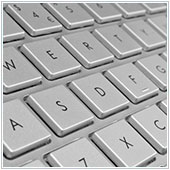 Navigation and interaction with a computer is typically done through a keyboard and a mouse. In some programs, worksheets for instance, many users will rely on the keyboard simply because it’s quicker. This is one of the reasons why programmers have implemented keyboard shortcuts into programs like Microsoft Excel.
Navigation and interaction with a computer is typically done through a keyboard and a mouse. In some programs, worksheets for instance, many users will rely on the keyboard simply because it’s quicker. This is one of the reasons why programmers have implemented keyboard shortcuts into programs like Microsoft Excel.
If you have upgraded to Office 2013, you may not know of some of the useful keyboard shortcuts you can use in Excel. Here are 18.
Ctrl combinations
- Ctrl+PgDwn/PgUp – Switches in between worksheets. Pressing PgDown will move to the worksheet to the left, and PgUp will move to the worksheet to the right.
- Ctrl+Shift+$ – When a cell or cells are highlighted, this will apply currency formatting with two decimal places and negative numbers in parentheses ().
- Ctrl+Shift+% – When a cell or cells are highlighted, this will apply percentage formatting with no decimal places.
- Ctrl+Shift+# – When a cell or cells are highlighted, this will apply the date format with day, month and year.
- Ctrl+A – With no columns or rows selected will select every cell in the workbook.
- Ctrl+C – With a cell(s) selected will copy the information in the cells.
- Ctrl+V – With a cell(s) selected will paste the copied information in the cells.
- Ctrl+Z – Will undo the last action.
Function combinations
- Alt+Shift+F1 – Will insert a new worksheet.
- Shift+F2 – When a cell or cells are selected will allow you to insert a comment, or edit an existing comment.
- F4 – Repeats the last command or action if possible.
- F6 – Will switch between the worksheet, Ribbon, Task pane and Zoom controls.
- F7 – Will run the spell check on the currently open worksheet.
- F11 – If you press this when you have cells selected, this will create a chart with the data in a new chart sheet.
Other useful keys
- Arrow keys – Will move one cell up, down, left or right in the current worksheet you are looking at.
- Delete – Will clear the currently selected cells of all information while keeping any formatting and comments.
- Page Down/Up – Pressing Page Down will move one screen down in the worksheet you are currently looking at, while Page Up will move one screen up.
- Tab – Will move one call to the right in the worksheet and will confirm and enter information if you already have it in one cell.
There are many other keyboard shortcuts and combinations you can use in Excel, these are the common ones that many users will use on a regular basis. If you would like to learn more about Excel or any of the other Office programs, please contact us today to see how we can help.
 Navigation and interaction with a computer is typically done through a keyboard and a mouse. In some programs, worksheets for instance, many users will rely on the keyboard simply because it’s quicker. This is one of the reasons why programmers have implemented keyboard shortcuts into programs like Microsoft Excel.
Navigation and interaction with a computer is typically done through a keyboard and a mouse. In some programs, worksheets for instance, many users will rely on the keyboard simply because it’s quicker. This is one of the reasons why programmers have implemented keyboard shortcuts into programs like Microsoft Excel.